This page contains the AQA GCSE Physics P1 Energy and Energy Resources Kerboodle Answers for revision and understanding of AQA GCSE Physics P1 Energy and Energy Resources . This page also contains the link to the notes and video for the revision of this topic.
P1.1 Changes in Energy stores AQA GCSE Physics P1 Energy and Energy Resources Kerboodle Answers. Page no -5
1 a When the balls fall in the ai, it speeds up as it
falls. The force of gravity acting on the object’s cause energy to be
transferred from its gravitational potential energy store to its kinetic energy
stores.
belectrical energy → heat to a heater element, some
heat → surroundings
2 a Any two from e.g., electric torch: chemical
energy stored in battery → electric· current transfers energy to lamp →
light or heat energy → surroundings, e.g., candle: energy from chemical
reactions when candle burns· → light or heat energy → surroundings
bi candle
ii electric torch
3 aThe changes in energy gravitational potential energy
stored in an electric train as it moves up a hill at constant speed.
b As we know from our work on kinetic energy, the
faster an object is moving the more kinetic energy it has. To stop a train from
we need to apply a force to kinetic energy into other forms such a heat. This
is what brakes do-they apply a force in the opposite direction to the motion of
the train. This cause deceleration and eventually the train stops.
4 The electrical energy supplied to the oven used to
generate microwaves. Then microwaves make food particles move faster so food
becomes hot.

P1.2 Conservation of energy AQA GCSE Physics P1 Energy and Energy Resources Kerboodle Answers Page no -7
1 a Brake pads become hot due to friction and energy
transferred from brake pads to surroundings as heat braking → sound energy →
surroundings
b KE → GPE in roller coaster → KE in air going up GPE →
KE going down
2 Descent: GPE → KE + heat to surroundings due to air
resistance impact: KE → elastic energy of trampoline + heat to surroundings due
to impact + sound ascent: elastic energy of trampoline → KE → GPE + heat to
surroundings due to air resistance
b Less
energy at top of a bounce than at the point of release
c Clamp meter ruler vertically over middle of a
trampoline, hold ball next to ruler with lowest point level with top of ruler,
release ball and observe highest level of bottom of ball after rebound, repeat
several times → average rebound position, repeat with same ball for other two
trampolines, highest rebound position → bounciest
3 Elastic energy of rubber straps → KE of capsule KE →
GPE ascapsule
KE → GPE ascapsule.

P1.3 Energy and work AQA GCSE Physics P1 Energy and Energy Resources Kerboodle Answers. Page no -9
1 ai chemical energy stored in rower’s muscles → KE of
boat and water + heat to surroundings
iimotor KE → GPE of barrier + thermal energy from
friction and sound energy
b2000 N × 40 m = 80 000 J
2 KE of car → brake pads by friction between brake
pads and wheel discs so brake pads become warm
b7000 N × 20 m = 140 000 J.
3ai20 N × 4.8 m = 96 J
ii80 N × 1.2 m = 96 J
b1400 J/ 7.0 m = 200 N
4 a 25 N × 12 m = 300 J
b Chemical energy stored in student’s muscles → KEin
box, when box moving KE + GPE of the box does not
change the frictional force between box and floor transfers energy by heating from
box to floor

P1.4 Gravitational potential energy stores AQA GCSE Physics P1 Energy and Energy Resources Kerboodle Answers. Page no -11
1 a descent:GPE of ball transferred by force of gravity →
KE of ball, + KE of air pushed aside by ball moving, impact: KE of ball →
elastic energy of ball + some elastic energy → KE as it rebounds, after impact:
KE of ball → GPE of ball as it rises → KE of air pushed aside by ball as it
moves through the air.
bimg = 1.4 N EP = 1.4 N × (2.5 m – 1.7 m) = 1.1 J
iiEnergy → surroundings due to air resistance as ball
moves
through air,
energy transfer due to heating of ball when it is deformed.
energy → surroundings
by sound waves when ball hits floor.
2 a 450 N × 0.20 m = 90 J
b50 × 90 J = 4500 J
3 25 kg × 10 N/kg × 1.8 m = 450 J
bBall falls 1.8 m – 0.3 m = 1.5 m EP =mgh= 25 kg × 10
N/kg × 1.5 m = 375 J
4 Energy supplied by blood system to biceps to keep
muscle contracted, no work done on object as it doesn’t move, energy supplied
heats muscles → heat to surroundings

P1.5 Kinetic energy and elastic energy stores AQA GCSE Physics P1 Energy and Energy Resources Kerboodle Answers.Page no -13
1 a i) 0.5 × 500 kg × = 36 000 J
ii) 0.5 × 0.44 kg × = 88 J
1 b EK = 1 /2 = 2
× 36 000 J so 1 2 × 500 kg × v 2 = 72 000 J
∴ = 72 000 J/ 0.5 × 500 kg
= 288 /∴ v = 17 m/s
2 i) work done by muscles transfer chemical energy from
muscles → elastic PE of catapult
ii) Elastic PE of catapult → KE of object
b2.0 N × 5.0 m = 10 J 1
ii mass = weight/ g = 2.0 N /10 N/kg = 0.20 kg
assume all elastic
energy → KE in object, = 1 /2 = 10 J
so 1/ 2 × 0.20 kg
× = 10 J
∴ = 10 J /0.5 × 0.20 kg
= 100 /
∴ v = 10 m/s
3 a work done by brakes = energy transferred from
kinetic store = 360 000 J
using W = Fs → 360 000 J = F × 100 m
∴ F = 360 000 J/ 100 m = 3600 N
b1/ 2 × m × = 360 000 J
∴ 0.5 × m × 900 = 360 000 J
rearranging → m = 360
000 J/ 0.5 × 900 m2 /s2 = 800 kg
4 Elastic energy = 1 /2 = 0.5 × 250
N/m × (0.21 m)2 = 5.5 J

P1.6 Energy dissipation AQA GCSE Physics P1 Energy and Energy Resources Kerboodle Answers. Page no -15
1 a Wasted: sound, KE of air
bUseful: light and sound, wasted: heat
cUseful: boils water, wasted: heat lost through
surfaces, sound
dUseful: sound, wasted: heat loss
2 Gear box would heat up due to energy transfer
through friction between the gears, the hotter the gear box, the less efficient
the gears, if gear box becomes very hot, stops working as oil in it burns up
and gear wheels wear away
b Inside of shoes heat up due to energy transfer (by
conduction + infrared radiation) from feet which rub, feet transfer less energy
as shoes warm up so feet and athlete become hotter
C Drill heats up due to friction between rotating
drill and wood, if drill becomes very hot, it burns wood creating smoke
d Discs heat up due to
energy transfer by friction between discs and brake pads, KE of car decreases
3 a As pendulum swings towards middle GPE decreases and
KE increases, as it moves from middle to highest position its KE → GPE, air
resistance causes some KE → heat to surroundings
bAs air resistance opposes motion KE from pendulum
→air until pendulum stops moving and has no KE, energy transferred to air
dissipated to surroundings
4 Friction at wheel axles and air resistance reduces
KE of cyclist and KE → heat to surroundings sound might also be created and →
energy to surroundings.

P1.7 Energy and efficiency AQA GCSE Physics P1 Energy and Energy Resources Kerboodle Answers. Page no 17
a.Useful energy <
energy supplied
iEfficiency = useful energy delivered input energy
supplied a machine never > 100% efficient because useful energy delivered
never > total energy supplied
iiUseful energy always < total energy supplied, due
to electric currents in circuit wires/components and friction between moving
parts, energy dissipated by transferring heat to surroundings
a 60 J − 24 J = 36 J
b 24 J/ 60 J (× 100) = 0.40 (or 40%)

P1.8 Electrical appliances AQA GCSE Physics P1 Energy and Energy Resources Kerboodle Answers.Page no -19
aWD winding clockwork spring up to store energy in
spring
bSpring drives small electric generator in radio,
energy → from spring to generator by force of spring when spring unwinds,
current from generator → energy to radio circuits
cAdvantage: no replacement
batteries needed
disadvantage: spring needs to be rewound after unwinding.
aAny one from heat water
spray it and pump it
out
a 80% × 60% = 48%
b (100% − 48%) = 52%

P1.9 Energy and power AQA GCSE Physics P1 Energy and Energy Resources Kerboodle Answers.Page no -21
iMains filament bulb
ii10 000 W electric cooker
b2 million × 3 kW = 6 million kW
2 a 5000 W × 20 s = 100 000 J
b12 000 J (× 100) 100 000 J = 0.12 (or 12%)
3 a 1500 kJ 50 s = 30 kW
b30 kW /100 kW = 0.30 (or 30%)
4 a Current through heater → energy to heater raising
temperature of water, pump → energy to water to keep water moving enabling
water to overcome resistive forces due to pipes, energy → to surroundings by
sound waves frompump
b12 000 W × 4800 s = 960 000 J

Summary questions AQA GCSE Physics P1 Energy ans Energy Resources Kerboodle Answers.Page no -22
1 energy transferred by electric current to heater and
motor in heater,increases store of thermal energy so becomes hot in fan motor,
transferred to air as kinetic energy air warmed by heater heats objects and
material it comes into contact with heater warms fan heater case and vibrating
parts of heater create sound waves
b energy transferred where wanted in way wanted in fan
heater, transferred by current to heater transferred heat air creating
convection currents and keeping motor turning to make air move
ii energy transferred that is not useful in fan heater,
kinetic energy from vibrations of motor transferred as sound waves and by
heating fan heater case
2 a loses gravitational potential energy and gains
kinetic energy some energy lost due to air resistance
ii loses more gravitational potential energy and all
kinetic energy
energy lost mostly
transferred as elastic energy into rope
some energy may be lost
due to air resistance
b maximum kinetic energy when rope taut
if 100% efficiency,
maximum kinetic energy = 12 000 J
3 a i7000 kW × 300 s = 210 MJ
ii23 m/s × 300 s = 6900 m
iii210 000 000/6900= 30 435
≈ 30 000 N
iva =
zero so resultant force = zero
as driving force and
resistive force must be equal and opposite in
direction
b train gains gravitational potential energy as it
travels upan incline
rate it transfers
energy to surroundings unchanged as speed same and
resistive forces
unchanged
so output engine power
needs to be greater as energy must be
transferred to train as
gravitational potential energy as well as to
surroundings
4 a mg = 150 N
EP = 150 N × 1.2 m = 180 J
bW =
11 N × 20 m
= 220 J
c trolley did not gain kinetic energy as speed constant
trolley gained 180 J
gravitational potential energy which is 40 J < work
done by student
resistive forces such
as friction at trolley wheels → 40 J to surroundings
as waste energy
5 a energy initially stored in the stretched cord as
elastic potential energy →
arrow as kinetic energy
when cord released
as arrow gains height,
its kinetic energy decreases and gravitational
potential energy
increases
at maximum height, arrow
has maximum gravitational potential energy
and minimum kinetic energy
as it travels
through air, some energy transferred to air due to air
resistance
b I 0.5 × 0.015 kg × (25 m/s)2
= 4.7 J
ii0.015 kg × 10 N/kg × 20 m
= 3.0 J
iii4.7 J − 3.0 J
= 1.7 J
EK = ½mv2 = 1.7 J so ½ × 0.015 kg
× v2 = 1.7 J
v2 = 1.7 ��
0.5 × 0.015 kg = 227
m2/s2
v = 15 m/s
6 a EK
= 0.5 × 75 kg × (60 m/s)2
= 135 kJ
bi 0.5 × 75 kg × (5 m/s)2
= 940 J
ii a 75 kg × 10 N/kg × 900 m
= 675 kJ
cW =
(GPE + KE) at start – KE after = 675 kJ + 135 kJ − 940 J
= 809 kJ
7 a i mgh =
500 N × 3.0 m
= 1500 J
ii energy supplied = 600 W × 25 s = 15 000 J
energy wasted = 15 000
J − 1500 J = 13 500 J
b1500 J/15 000 J
= 10%
Practice questions AQA GCSE Physics P1 Energy and Energy Resources Kerboodle Answers.Page no -23
01.1 5 096 joules
01.2 friction between runner’s shoe and ground
Or air resistance
02.1 20.25 minutes
22.75 minutes
18.5 minutes
02.2 to ensure measurements are repeatable
02.3 to allow a comparison to be made
02.4 to avoid bias in the results
02.5 shaver C
02.6 18.3 W
03.1 23 275 joules
03.2 2328 W
03.3 0.65 or 65%
03.4 Heat between surfaces dissipated into air
04.1 as the height increases the GPE
Increases they are
directly proportional
04.2 8800 joules
04.3 89 m/s
05.1 1152 joules
05.2 to ensure the springs return to original length
after bounce
05.3 for safety reasons in case they snap.
Disclaimer
Disclaimer: I have tried by level best to provide the answers and video explanations to the best of my knowledge. All the answers and notes are written by me and if there is any similarity in the content then it is purely coincidental. But this is not an alternative to the textbook. You should cover the specification or the textbook thoroughly. This is the quick revision to help you cover the gist of everything. In case you spot any errors then do let us know and we will rectify it.
References:
BBC Bitesize
AQA GCSE Science Kerboodle textbook
Wikipedia
Wikimedia Commons
Join Our Free Facebook Group : Get A* in GCSE and A LEVEL Science and Maths by Mahima Laroyia: https://www.facebook.com/groups/expertguidance.co.uk/
For Free Tips, advice and Maths and Science Help
This page contains the detailed and easy notes for AQA GCSE Physics Energy for revision and understanding Energy.
Banner 1
AQA GCSE Paper 1: Complete Revision Summary
ENERGY
Banner 2
4.1 ENERGY
- Energy Stores
- Energy Transfer
- Kinetic Energy
- Potential Energy
- Power
- Efficiency
- Energy Transfer
- Sources of Energy
DIFFERENT FORMS OF ENERGY
- Kinetic energy: kinetic energy is the energy stored in something that moves.
- Light energy: energy carried by the wavelength of a photon.
- Gravitational energy: the energy of gravity or the work done against gravity.
- Thermal energy: thermal energy is the heat or vibration of atoms.
- Electricity: the energy carried by the movement of electrons.
- Chemical energy: chemical energy is the energy contained in the bonds between atoms in molecules.
- Nuclear energy: energy stored in the nuclei of atoms. The nucleus of each atom is composed of neutrons and protons that are held together by strong bonds of energy.
- Sound energy: the energy of the vibrations that travel through a fluid.
- Magnetic energy: correlated to electrical energy, magnetic energy is also a product of the movement of electrons and their ability to produce a field.
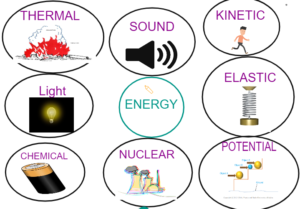
FORMS OF ENERGY
| ENERGY | DEFINATIONS | EXAMPLE |
| Thermal Energy | Energy from the heated objects. | Energy in Kettle |
| Light Energy | Energy that helps to see. | Bulb, Torch |
| Electrical Energy | Energy due to the flow of charge or current | Electrical Appliances |
| Chemical Energy | Energy stored in the chemical bonds | Food, Batteries |
| Sound Energy | Energy due to vibrations | Loudspeaker |
| Nuclear Energy | Energy stored in the nucleus of the atom | Nuclear Reactor |
| Kinetic Energy | Energy due to movement | Roller coaster moving down |
| Potential Energy | Energy due do the position | Ball raised to a height |
| Elastic Energy | Energy stored in stretch objects | Springs, Rubber |
Banner 3
ENERGY TRANSFER
Law of Conservation of Energy: Energy is neither created nor destroyed. It changes from one form to another.
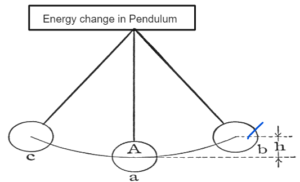
- At the extremes pendulum gains kinetic energy.
- As it comes back to mean position kinetic energy converts to gravitational potential energy.
- It goes to a height and gains potential energy.
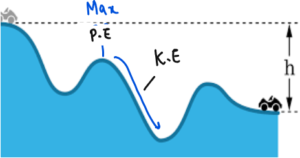
- The potential energy is converted into kinetic energy when it moves.
Banner 4
WORK AND ENERGY FORMULAE
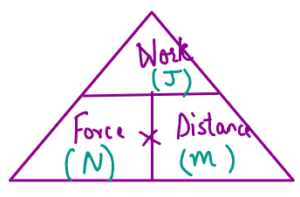
Potential Energy P.E = m x g x h
Potential energy in Joules (J) g is the gravitational field strength in N/kg, and h is the height in metres (m).
Kinetic Energy K.E = ½ mv2
m is the mass in kilograms(kg), v is the speed(m/s) and the kinetic energy in joules(J).
Elastic Potential Energy E.P.E. = ½ ke2
Elastic potential energy in joules (J), k is the spring constant in N/m and e is extension in metres (m).
Efficiency = useful output/ Total input x 100
Efficiency is the relationship between the useful work done by a machine, an engine, a device, etc. And the energy supplied to it, often expressed as a percentage.
- m: mass of the object
- g: Acceleration due to gravity
- v: velocity of an object
- k: spring constant
- e: extension
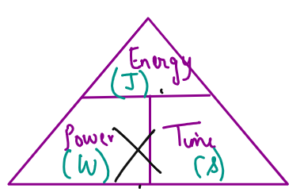
Banner 5
Examples
Q1 Calculate the work done when 2 N of force moves a block to a distance of 2 m
W =F x S = 2 x 2 = 4J
Q2 Calculate the kinetic energy when a 2kg block moves at the speed of 3 m/s
K.E = ½ mv2
½ x 2 x 32 = 9J
Q3 Calculate the potential energy when the mass of 2 Kg is raised to a height of 5m above the ground.
P.E = mgh
2 x 10 x 5 = 100J (g = 10m/s2)
Q4 Calculate the energy dissipated by a 10 W bulb in 2 minutes
E = P x t
= 10 x 2 x 60
= 1200J
HOOKE’s LAW
The extension produced in an elastic object is directly proportional to the force applied on it.
F ∝ e
F = ke
Elastic Potential Energy = ½ ke2
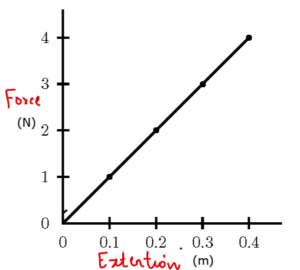
ENERGY EFFICIENCY
Energy efficiency, means using less energy to provide the same level of energy.
All appliances do not convert 100% of the input energy into useful energy.
The waste energy is dissipated to the surroundings.
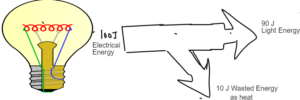
Energy efficiency = Useful/total x 100
= 90/100 x 100
= 90%
USEFUL AND WASTE ENERGY
| Device | Useful Energy | Waste Energy |
 | Light Energy | Heat Energy |
 | Kinetic Energy | Heat and Sound Energy |
 | Heat Energy | Light and Sound |
FRICTION
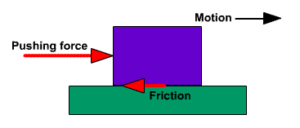
Friction is the force that opposes the motion of the body.
It results in loss of energy.
Methods to prevent friction:-
- a) Lubricate, paint or smooth the surface by regular oiling of the machines
- b) Streamline the body of the object like ship or plane to cut down air resistance
- c) Tighten the loose parts to prevent friction and reduce sound energy.
Banner 7
HEAT TRANSFER
CONDUCTION
- The process by which heat is transferred by the direct contact of the particles and the particles vibrate and conduct heat.
- Greater the transmission greater is the thermal conductivity of the material.
CONVECTION
- Heat transfer through fluids in which the hot molecules rises and the cold molecules sink generating a convection current.
RADIATION
- The process of heat transfer by electromagnetic radiation. There is not a direct contact between the two surfaces.
- The stove element heats the kettle and the kettle heats the water by conduction. Water circulating in the kettle transfers heat by convection. Near the stove, air would feel warm due to heat transfer by radiation.
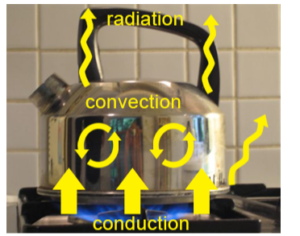
Banner 8
GREENHOUSE EFFECT
- It is the natural process that warms the surface of the Earth.
- When the Sun’s energy reaches the Earth’s atmosphere, part of it is reflected in space and the rest is absorbed and re-irradiated by greenhouse gases.
- Greenhouse gases include water vapor, carbon dioxide, methane, nitrous oxide, ozone and some artificial chemicals such as chlorofluorocarbons (CFCs).
- The energy absorbed warms the atmosphere and the surface of the Earth. This process keeps the Earth’s temperature at about 33 degrees Celsius warmer than it would be, allowing life on Earth to exist.
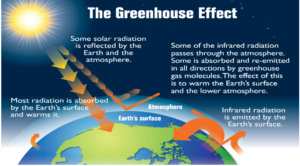
ENERGY LOSS IN HOMES
LOFT INSULATION
- Uses fibre glass in the loft.
- Fibre glass is an insulator and prevents the heat loss by conduction.
- Thicker the layer better the conduction.
CAVITY WALL INSULATION
- It is the insulation between the two layers of the bricks.
- The insulation between the bricks traps air and prevent loss of energy by conduction.
DOUBLE GLAZING
- Thicker glass with dry air or vaccum in between.
- Glass has lower conductivity and air act as an insulator prevent loss by conduction.
- The vaccum prevent loss by convection.
THICK BRICKS
- Thick bricks with lower thermal conductivity prevents the loss of heat by conduction.
FOILING
- Foiling between the radiator and the panel reflect the heat back into the home and prevent it from escaping.
SOURCES OF ENERGY
RENEWABLE
- The source of energy that can be replinished and will never run out.
- Eg – Solar, Wind, Geothermal
- Does not produce any harmful or greenhouse gases
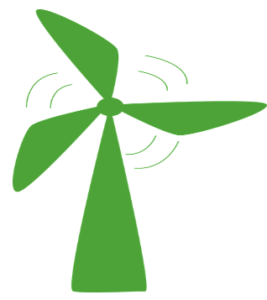
NON RENEWABLE
- The source of energy that cannot be replinished and will run out.
- Example: Fossil Fuels like coal, petrol, natural gas
- Produces harmful greenhouse gases.
BIOFUELS
- Making methane, ethanol or other fuel by using plant and animal waste which is :
- Biofuels convert the energy of the sun into plant materials, which are then processed to produce liquid fuels.
- Biofuels include ethanol, which can be replaced by gasoline in many recent model cars.
- For this reason, biofuels are particularly useful for meeting the energy needs of the transport sector.
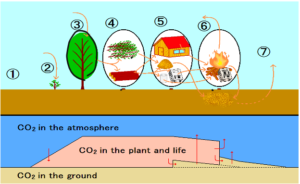
Banner 9
RENEWABLE SOURCE OF ENERGY
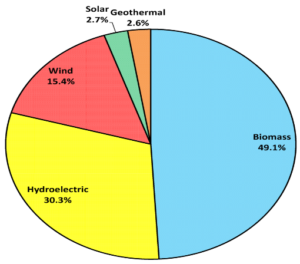
ENERGY ISSUES
Reliability
Cost
Demand – With the increase in global energy demand, common fossil fuels that produce energy, such as coal, oil and natural gas, are running out
Supply
KEY TERMS
- Kinetic energy: kinetic energy is the energy stored in something that moves.
- Gravitational Potential energy: the energy of gravity or the work done against gravity.
- Elastic Energy – Elastic energy is the potential energy stored as a result of the deformation of an elastic object, such as the stretching of a spring.
- Work Done – Work is done when a force moves something over a distance.
- Power – power is the rate of doing work or of transferring heat,
- Energy efficiency – means using less energy to provide the same level of energy.
- Useful Energy – Energy transferred in the form and where it is desired
- Waste Energy – The energy which is transferred to the surroundings is wasted.
- Friction – Friction is the force that opposes the motion of the body.
- Conduction – The process by which heat is transferred by the direct contact of the particles and the particles vibrate and conduct heat.
- Convection – Heat transfer through fluids in which the hot molecules rises and the cold molecules sink generating a convection current.
- Radiation – The process of heat transfer by electromagnetic radiation. There is not a direct contact between the two surfaces.
- Greenhouse Effect – It is the natural process that warms the surface of the Earth.
- Renewable Energy – The source of energy that can be replinished and will never run out.
- Non renewable Energy – The source of energy that cannot be replinished and will run out.
- Biofuel – Biofuels convert the energy of the sun into plant materials, which are then processed to produce liquid fuels.
- Tidal Energy – It is a form of hydropower that converts the energy obtained from tides into useful forms of power, mainly electricity.
- Solar Energy – Radiation from the Sun capable of producing heat, generating electricity.
Banner 10
Disclaimer:
I have tried my level best to cover the maximum of your specification. But this is not the alternative to the textbook. You should cover the specification or the textbook thoroughly. This is the quick revision to help you cover the gist of everything. In case you spot any errors then do let us know and we will rectify it.
References:
BBC Bitesize
Wikipedia
Wikimedia Commons
Image Source:
Wikipedia
Wikimedia
Commons
Flickr
Pixabay
Make sure you have watched the above videos and are familiar with the key definations before trying these questions. It is also good to time yourself while doing these questions so that you can work on the speed as well.
P1- Energy
